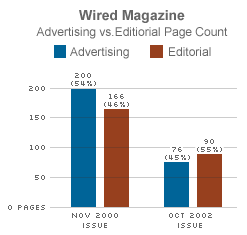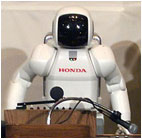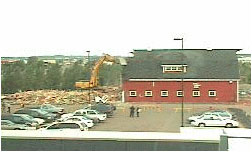Search Google for “MSSQL” and it will ask you:
“Did you mean: MYSQL“
See a screenshot.
Search Google for “MSSQL” and it will ask you:
“Did you mean: MYSQL“
See a screenshot.
Human: Puts $2 coin1 in machine – requests item that costs $1.25.
Machine: “EXACT CHANGE ONLY”
Human: With no $1 coin on hand, puts in a quarter.
Machine: “EXACT CHANGE ONLY”
Machine: Stares silently.
Human: Presses the button to return change.
Machine: Returns $2.25 in the form of two $1 coins2 and a quarter.
Human: With newly denominations, puts $1.25 in machine – requests item that costs $1.25.
Machine: Dispenses item.
I’m sure you’ll see this on every weblog around in the next few days, but I thought it was worth posting here in light of my open letter on CSS and the response it got. Wired News has completely redesigned their entire in standards compliant XHTML/CSS. It looks great, you can re-size the fonts in your browser, and Netscape 4 users (or any older browser) will just see the plain old content (screenshot) – not pretty, but completely accessible.
This certainly defeats the misconception that XHTML/CSS can work for simple weblog sites, but not realistically for a major content site. The next step will be to see a big name ecommerce company make the move.
Netscape 4 users are going to notice a pattern in the next year – sites are going to start looking a lot more like they did in 1997.
About two years ago, I wrote about how Wired Magazine was so heavy with advertising. I thought I would update the stats and compare the November 2000 issue with the current, October 2002 issue.

| Nov 2000 | Oct 2002 | |||
| Advertising: | 200 (54%) | 76 (45%) | ||
| Editorial: | 166 (46%) | 90 (55%) | ||
| Total Pages: | 366 | 166 |
The more interesting result of the comparison is not the ratio of ads to editorial content (which changed only slightly in favour of editorial in the 2002 issue), but rather the total number of pages. The October 2002 issue is less than half the size of the November 2000 issue.
At the time I thought I was making some clever observation about the commercial nature of the publication. However, while revisiting the stats, it occurred to me that the ratio of advertising to editorial content doesn’t really have any bearing on the quality of the content. You could have 20 pages of great editorial content bundled in with 500 pages of ads, and it would make the editorial content any less valuable (would it?).
The distinction between hardware and software is artificial. The difference between the two is only one of scale: hardware works in the world of matter, software works in the world of energy1. However, whether you’re manipulating atoms, or electrons, you’re still just using the ‘rearranging of the physical’ as a tool (whether it be a hammer, or accounting software).
This is why it is possible for software and hardware to interact. This is why, when you press a mechanical key on your keyboard, a ‘virtual’ character can appear on the screen. This is why when a ‘virtual’ trigger is sprung, a physical activity can be initiated (when a conditional statement is true, the gears in your printer will turn).
Hardware and software are not two separate worlds. Rather, they are more like the ocean and the atmosphere of Earth: two varieties of the same concept. In practical terms, we think of the ocean as full of something, but of the atmosphere as empty. Really, we are just swimming in an ocean of air. The ocean and atmosphere are both fluids; one of water, one of air. So too is it with hardware and software, one of molecules, and one of electrons. Software is a machine.
If we can accept this premise, that there is really no clear distinction between hardware and software (other than a definitional distinction, much like the atmosphere and ocean), then we can extend the premise to ourselves. Human beings consist of hardware (our bodies) and software (our minds). Depending on your belief system, the soul may be part of the software layer, or may transcend both. However, this is beyond the scope of this article. Just like hardware and software are two ends of the same spectrum, so top are the human mind and the physical body.
If you write the alphabet in sand with a stick, all you have done is rearrange particles of sand. I’m not sure where to go with this. Perhaps this is just circular logic, a stating of the obvious (everything in the universe is just part of the universe – hardly groundbreaking). I’m clearly not breaking any new ground here. However, I think I have finally reconciled for myself, at least in theoretical terms if not in practical terms, what had always struck me as an incongruity: how software and hardware can interact – how moving a mouse can make a cursor move.
Somebody, please tell me they know what I’m talking about.

This is old news, but I’ve been looking for video of this ever since I heard about it a few months ago: Asimo, Honda’s “humanoid robot” playing soccer (it’s the first video on the page – or download the RealVideo file). It is enormously entertaining.
It’s a bit creepy, yes, but the copyright-free musak version of Walkin’ on Sunshine sure helps lighten the mood. This is totally worth watching. At about 3:50 into the clip, the robot “raises the roof”. Don’t miss it.
Oh, and next time a robot rings the opening bell at the New York Stock Exchange, can somebody tell me!
Last night, the CBC ran a series of interviews with high-ranking Canadian politicians about their experiences during September 11, 2001 (see an excerpt [20 min RealVideo]). What made the interviews particularly engaging was that the nature of the conversation was candid, personal, and it would seem, honest.
The discussion with Prime Minister Chrétien was particularly interesting. He spoke about the experience of debating the order to, if necessary, shoot down a passenger airliner that was thought to have been hijacked. What was so interesting was that Chrétien wasn’t speaking as the Prime Minister. Rather, he was speaking as an individual – as a human being in a difficult situation.
He also spoke of the disparity of wealth between the west and east. Again, his words had the air of frankness and honesty. Honesty is not something you often see from someone who represents so many. It really jumps off the screen at you. Politicians are generally forced to watch every word they say in press conferences. The smallest remark could be misinterpreted or taken out of context by the press or opposition.
Former Finance Minister Paul Martin, Minister of Transportation David Collonette, and the Minister of Finance and Deputy Prime Minister John Manley all spoke about their memories of that day. All said things they wouldn’t dare utter in a press conference.
This kind of honesty should be applauded and encouraged. Predictably, some of the opposition seized the opportunity to criticize both fairly, in Joe Clark’s comments about foreign aid (see video excerpt [RealVideo]), and unfairly, in Stephen Harper’s opportunistic attack. Joe Clark did come to the defence of the Prime Minister though, saying that much of the criticism was taking the Prime Minister’s comments out of context.
The backlash to the honest expression of opinions like this leads to an environment of antiseptic and empty public speaking.
That said, I’m not gonna vote for any of these guys – I’m with the Barenaked Ladies: let’s go left.

From News.com: Anti-radiation pants
“Clothing manufacturer Levi Strauss is gearing up to launch a pair of trousers with an “anti-radiation” cell phone pocket, prompted by customers’ concerns about the possible health risks of mobile phone use.”
Now we just need pocket microwave ovens.
Using a computer often gets branded with the same attributes as watching TV. It is often seen as antisocial and a waste of time. These machines rot our brains, right? Well, this past week I spent some time away from my computer, and I’ve come to a different conclusion.
First, I should clarify; I’m no monk – it was just a few days, but it was quite a change from my routine.
What I found was that my computer isn’t rotting my brain at all. Rather, I use my computer for all kinds of activities that I would generally consider quite healthy and positive.
I use my computer to write. I use my computer to read (all kinds of great stuff), I use my computer to communicate (with real people). I write for this site, I write for my intranet at work. I (attempt to) compose and record music. I communicate with people through email, through discussions on this site other others.
I also realized how much practical “real world” stuff I do online. For example, this week I constantly found myself wanting to do things like check the movie listing for the local independent cinema (aren’t I cool?), look up more detail on a news story I heard on CBC Radio (btw, CBC Radio is my new best friend), or even just taking care of some banking. Sure, I could call the cinema, and walk to the bank (which I did), but there is no offline equivalent to the ability to dig up details and background on a radio news story. Oh, and it turns out that banking online is a far more inviting and humanizing experience than actually going to the real bank.
I’ve learned this week that I use my computer (and the Internet) to do good things – things that I enjoy, at least.
A computer is just a tool (Marshall McLuhan be damned!). The computer is just as content to help you map the human genome as it is to show you hardcore midget porn. It will be interesting to see if the popular conception of what it means to “use a computer” will change. It might sound like a waste of time if I told you I spent all weekend “on the computer”, but what if I told you I was writing a novel, or composing a symphony (not that I’ve done either of these things).
This isn’t to say that I use my computer solely as a tool for enlightmentment. In fact, just last year I suffered a nasty adiction to Tony Hawk Pro Staker 2.
For more the on the “cult of Turn Off Your Computer”, read Curt Cloninger’s article, The Cult of “Turn Off Your Computer” Must Die.
The bar at our local university was called The Barn – this was due to the fact that is was – a barn. Apparently it used to actually be home to farm animals before it became a money-losing concert hall.

It was torn down today. A necessary move (it was probably getting dangerously decrepit), but it will be missed.
I can remember some great concerts there: Sloan, Thursh Hermit, Local Rabbits, The Watchmen, Treble Charger, Sum41 (before they were rock stars), The Flashing Lights, Horton’s Choice, 54-40, Stawberry, and a few others.
It was a great venue. It sounded great, and was small enough that even the smallest shows felt packed. I’ll never forget seeing Sloan play in The Barn on their One Chord to Another tour. The place was packed well beyond safety, and it was unbearably hot inside – though it was -20 outside. In the middle of the set, someone opened a door on the balcony directly above and behind the stage. The temperature difference caused billows of fog to poor in over the stage. The band was probably pissed as their guitars warped out of tune, but it looked really cool.
The Barn is no longer, but you can watch it fall (1.6 MB animated GIF).